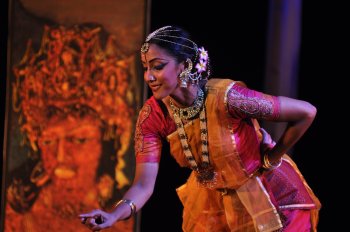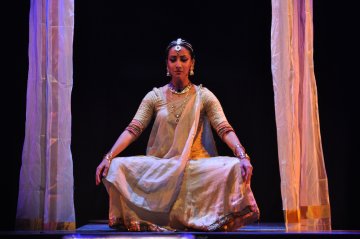
|   |

|   |
Yashodhara: A triumph of creative imagination - Dr. SD Desai e-mail: sureshmrudula@yahoo.co.in February 14, 2013 In an exquisite portrayal of Yashodhara with classical intricacy and elegance, as though an image of the quality of Ajanta paintings were finding flesh and blood, Mythili Prakash in her abhinaya takes care in Gowri Ramnarayan’s direction and choreography, not to appear pathetic with a feeling of dejection and being anathawat. On Maithilisharan Gupt’s line ‘Sakhi ve mujh ko kah kar jaate…’, her Yashodhara is an anguished manuni, who with poignant dignity expresses her feeling of hurt in getting stealthily abandoned by Siddharth with infant son Rahul in sleep.  Seated on the right of the stage, Amritha Murali renders the poet’s lines in classical tunes, thus aurally evoking the changing moods of the worthy nayika, with such nuanced abhivyakti, getting one with the moods, that besides taking in the aural images she creates, one cannot help looking at her intently from time to time. On the left, upright sits Gowri, her face gleaming with pride, looking now at the vocalist, now the dancer, now as it were pensive as the Sutradhar with a difference. Intermittently she rises, moves to the centre and as a modern enlightened person ruminating about Yashodhara’s being, state and situation, makes her observations, empathetic and marked with a questioning attitude. While the poet’s lines express the traditional unquestioning reverence for the Enlightened One, the Sutradhar’s slowly enunciated prose lines voice the concern of the modern woman for the nayika and a veiled criticism of the deified hero who through his action betrayed her trust ingrained in wedlock. The one who acquired compassion for the human kind, ironically, remained insensitive to the suffering being inflicted on his wife and son. With her impeccable aesthetic sense, Gowri is dependable for lyrically pithy experiences she creates through a refreshing combination of elements in theatre. Her inspiration, a lotus that flowers up in the warmth it receives in free air, has kinship with Tagore’s red oleander sprouting in free air from the very debris that was or could have been the cause of its end. The play luxuriates in such subtly expressive imagery – the verbal enriched by vocal, the visual with symbolically connotative.  Even as the theme of Yashodhara’s evolution from within – how potentially she was an equal of him and remained on an even keel! - keeps getting intricately portrayed with precision and enhanced, a delectable jugalbandi between the widely shared traditional reverence and the strikingly modern irreverence develops the subtly dramatic point-counter-point subtext of the performance piece that defies a genre label. Going back to the imagery, and to begin with the simplest, the oblong floral frame of the supposed mirror and the white cloth-hanging becoming a pillar for the nayika to rest her hand on besides Vajrapani and, later, Standing Buddha with a Begging Bowl painting illustrate economy without sacrificing significance and the recorder (wasn’t it?) remaining unnoticed in a red-bordered basket reflects taste. Turning to the subtler ones, the richly radiant royal adornment adding to the sculpturesque beauty of young Yashodhara in anguish relentlessly keeps suggesting the latent dramatic irony. Her tresses that signify sensuality for Prince Siddharth initially ironically turn a symbol of renunciation now for the abandoned young royal wife when she wipes the Enlightened One’s feet with them at her doorstep. Her evolution to bhikkhunipada, as recorded by history, is beautifully suggested by Mythili, in the dhyana position, with the mudras signifying the rise of the powers within from Mooladhar Chakra up to Sahasraar Chakra. ‘Yashodhara’ was staged at Natarani, Ahmedabad, as part of Darpana Academy’s Festival of Non-violence through the Arts, an annual event, earlier this month. Dr. SD Desai, a professor of English, has been a Performing Arts critic for many years. Among the dance journals he has contributed to are Narthaki, Sruti, Nartanam and Attendance. His books have been published by Gujarat Sahitya Academy, Oxford University Press and Rupa. After 30 years with a national English daily, he is now a freelance art writer. |